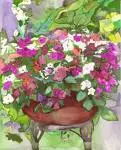Impatiens (Impatiens wallerana)
Richard K. ZimmermanWVU Extension ServicePlant Sciences & Conservation Specialist
Family: Balsaminaceae–Balsam family
Scientific Name: Impatiens wallerana
Origin: Tanzania to Mozambique
Classification: Annual, houseplant
Use: Hanging basket, bedding, pot culture, window boxes
Height: 9 to 30 inches
Spread: 9 to 30 inches
Hardiness: Indoors 50oF to 55oF (10oC to 13oC); outdoors until frost
Flowers: Early summer to fall; solitary in racemes on terminal and axillary shoots; up to 2� inches in diameter; solid colors of white, pink, salmon, purple, orange or red, and many bicolor; single, double and semi-double; numerous
Fruit: Capsule, � inch long, glabrous
Stems (Bark): Herbaceous, fleshy, green
Foliage: Alternative, upper leaves sometimes opposite; lanceolate-ovate; green or reddish green on both surfaces
Texture: Fine to medium
Growth Rate: Rapid
Form: Spreading, rounded, flat topped
Insects & Diseases: Scale, spider mites, aphids; damping off
Propagation: Seed sown indoors 6 to 8 weeks before last occurrence of frost (late February to mid-March); give bright light but not direct sun; artificial lights, such as Grow Lamps, should be used–place 6 to 12 inches above the flats for 12 to 14 hours a day; soil temperature should be 70oF (21oC) and air temperature 75oF (24oC) for good germination; seed should germinate in one to two weeks; grow plants at 58oF (14.4oC) to 60oF (15.5oC); cuttings, anytime, place in sand and mist or enclose in a polyethylene plastic bag.
Varieties: Many varieties and series introduced each year with varying colors and sizes.
Dwarf forms: 8 to 10 inches tall, compact, 12-inch spacing; many colors; series includes Elfin, Elfin Improved; Elfin Improved bloom earlier and more profusely.
Semi-dwarf forms: 10 to 12 inches tall, flowers 1 to 2 inches across; spacing 14 inches, solid and bicolored blooms; series includes Duet, Fantasia, Futura, Minette, Novette, Ripple (star pattern in blooms), Rosette (blooms like a miniature rose), and Twinkle.
Tall forms: 12 to 14 inches tall, flowers 1� to 2 inches across; solid and bicolors; spacing 18 inches; series includes Grande, Blitz, Stars and Stripes, Tangelow and Treasure; New Guinea-Indonesian hybrids have leaves with red or yellow markings and variegations, to 24 inches tall; good for pot culture.
Related Species: Impatiens balsamina–Garden Balsam or Rose Balsam; annual to 2� feet; flowers axillary, close to stem, 2 inches across, many colors, some spotted.
Remarks: May be called Balsam, Sultana, Touch-Me-Not, Snap Weed, Jewel Weed, Busy Lizzy, Patient Lucy, Patience Plant or Zanzibar Balsam; may be listed asImpatiens sultana or Impatiens holstii; stems and leaves reported to be toxic.
Indoor Culture
Soil Requirement: All-purpose soil composed of two parts garden loam, one part leaf mold or peatmoss and one part coarse sand; soil must be well drained.
Maintenance: Keep moist but not wet, barely moist in winter, use water that is room temperature, it is best to let water stand overnight before using; fertilize every two weeks with a houseplant fertilizer at one-half recommended rate, reduce fertilization in winter; ideal temperatures are 50oF to 55oF (10oC to 13oC) at night and 65oF to 70oF (18oC to 21oC) during the day; repot anytime as necessary.
Situation: Bright light, 4000 to 8000 foot-candles (southern or western window), will tolerate 500 to 2000 foot-candles (northern or eastern window).
Outdoor Culture
Soil Requirements: Slightly acid to neutral, good garden loam rich in organic matter such as leaf mold or compost with liberal amounts of coarse sand for good drainage.
Maintenance: Keep moist but not wet; fertilize every two weeks with a general fertilizer; plant out-of-doors after danger of frost has passed.
Situation: Sun or partial shade





 Propagation
Propagation










































 When Can I Plant Impatiens
When Can I Plant Impatiens 



















